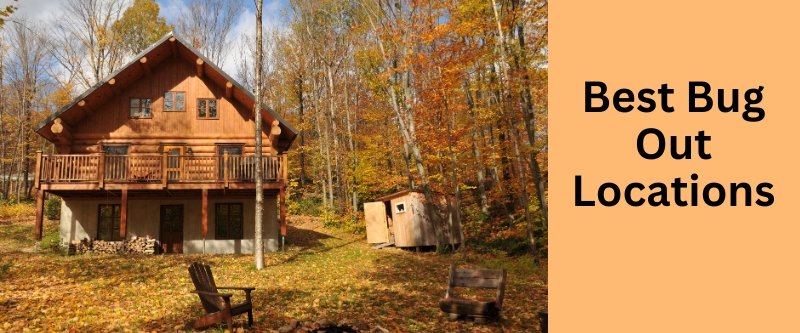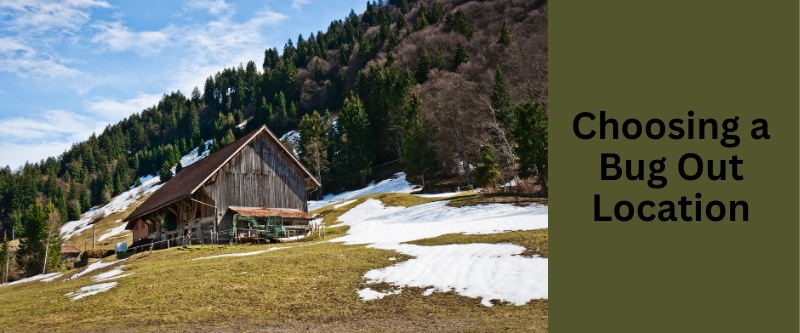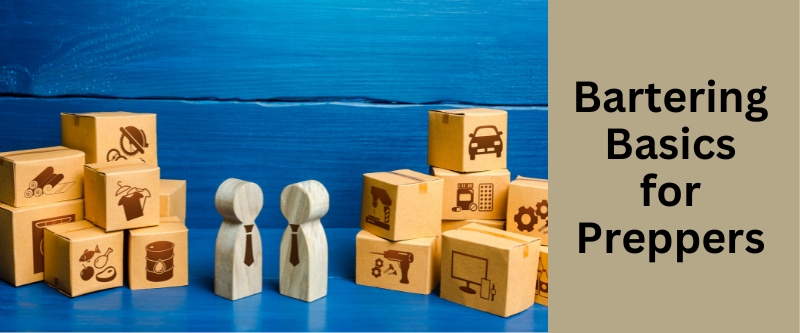Table of Contents
Emergencies and disasters are unpredictable, often striking when least expected. And in such times, having a safe haven can make the difference between survival and catastrophe.
This article goes deep into the concept of Bug Out Locations (BOL) and offers related insights, tips, and strategies.
Reality Check
A great deal of what we describe here is long on prepper theory – and that is fine. But as you go through this article, filter the thoughts and the recommendations through the reality of your own personal circumstances. We will have more on this at the end of the article.
Spoiler Alert: Live Bugged Out Already!
Introduction
In today’s volatile world, the importance of being prepared for emergencies cannot be overstated. From natural disasters like hurricanes and earthquakes to human-made crises such as civil unrest or economic collapse, the threats are real and ever-present. While many focus on stockpiling supplies at home, there’s another crucial aspect of preparedness that often goes overlooked: Bug Out Locations (BOL).
A BOL is more than just a backup plan; it’s a lifeline. It’s a place you can retreat to when staying at home becomes too dangerous. But how do you choose the right BOL? What factors should you consider? This guide aims to answer these questions and more, providing a comprehensive overview of BOLs and their importance in disaster preparedness.
Quote: “By failing to prepare, you are preparing to fail.” – Benjamin Franklin
What is a Bug Out Location (BOL)?
A Bug Out Location, often abbreviated as BOL, is a designated place where individuals or families can retreat in the event of a significant crisis or emergency. It’s a location away from one’s primary residence, specifically chosen and prepared to offer safety, shelter, and sustenance during prolonged times of uncertainty.
The Concept Behind Bugging Out
The term “bug out” has its origins in the military, referring to a rapid retreat or withdrawal under enemy threat. In the context of survivalism and prepping, “bugging out” means leaving your primary residence due to an imminent threat and heading to a safer location, i.e., the BOL.
While many people prepare their homes to withstand emergencies, there are situations where staying put (often termed “bugging in”) might not be the safest option. Severe natural disasters, civil unrest, or prolonged power outages are just a few scenarios where bugging out can become a necessity.
BOL vs. Everyday Residence
While your home is where you live daily, a BOL is a place specifically chosen and prepared for emergencies. It’s stocked with supplies, fortified against potential threats, and ideally situated in a location that offers natural protection and resources.
Key Differences
- Purpose: Your home serves your daily living needs, while a BOL is specifically for emergencies.
- Location: BOLs are typically in remote or less-populated areas, away from potential threats.
- Supplies: While you might have some emergency supplies at home, a BOL is extensively stocked for long-term survival.
- Fortifications: BOLs often have enhanced security measures, from reinforced structures to surveillance systems.
Why is a BOL Important?
In a world of uncertainties, a BOL provides a safety net. It ensures that, no matter how dire the situation at your primary residence, you have a backup plan—a place where you can find shelter, safety, and resources to sustain you and your loved ones.
- Safety: Away from urban chaos and potential threats.
- Resources: Stockpiled with essential supplies for long-term survival.
- Peace of Mind: Knowing you have a fallback plan can reduce anxiety during crises.
Why Do You Need a BOL?
In today’s rapidly changing world, the unexpected can happen at any moment. From natural disasters to civil unrest, the reasons for needing a safe haven away from your primary residence are numerous. A Bug Out Location (BOL) serves as that haven, offering protection, resources, and a strategic advantage during emergencies.
Natural Disasters
Whether it’s hurricanes, wildfires, floods, or earthquakes, natural disasters can render your primary residence uninhabitable. A BOL situated away from disaster-prone areas provides a secure place to retreat to when nature strikes.
Case Study: In 2005, Hurricane Katrina devastated New Orleans, leaving many without homes. Those with BOLs in safer areas were able to evacuate and find shelter, avoiding the worst of the disaster.
Civil Unrest and Societal Breakdown
Political instability, economic downturns, or other societal issues can lead to civil unrest. Riots, looting, and violence can make urban areas particularly unsafe. A BOL offers an escape from the chaos, providing a secluded and defensible location.
Prolonged Power Outages
Extended power outages can disrupt essential services, from water supply to communication. A BOL equipped with off-grid solutions, such as solar panels and rainwater harvesting systems, ensures you remain self-sufficient during such times.
Pandemics and Health Crises
As the recent COVID-19 pandemic has shown, having a place away from densely populated areas can be crucial during health crises. A BOL allows for social distancing, reducing the risk of infection.
Strategic Advantage
A well-chosen BOL offers a strategic advantage. Its location can provide natural barriers against threats, abundant resources, and a vantage point to monitor surroundings.
Strategic Advantage Examples
- Natural barriers like mountains or rivers.
- Abundant wildlife and vegetation for sustenance.
- Elevated positions for surveillance.
Peace of Mind
Beyond the tangible benefits, having a BOL offers peace of mind. Knowing you have a plan and a place to go during emergencies can significantly reduce stress and anxiety.
Key Considerations When Choosing a BOL
Selecting the ideal Bug Out Location is a multifaceted decision that requires careful thought and planning. Here are the primary considerations to keep in mind:
Proximity to Your Primary Residence
Your BOL should be close enough for a timely evacuation but far enough to ensure safety from immediate threats.
- Rule of Thumb: A location within one tank of gas is often recommended. (Ed note: We think this is risking it. We would say half a tank.)
- Tip: Plan multiple routes to your BOL to account for potential roadblocks or hazards.
Accessibility
The only BOL worth having is one you can reach when you need it most.
- Consideration: Seasonal changes. Some areas might be inaccessible during winter or rainy seasons.
- Possible Access Methods:
- Roads (paved or dirt)
- Waterways (for locations near rivers or lakes)
- Airstrips (for those with private planes)
Natural Resources
A BOL rich in natural resources can sustain you for extended periods.
- Water: Ensure access to clean, fresh water sources like springs, rivers, or lakes.
- Food: Look for areas abundant in wildlife, fish, and fertile soil for farming.
Defensibility
Your BOL should be defensible against potential threats.
- Consideration: Avoid locations near main roads or popular recreational areas.
- Tip: Dense vegetation, natural land depressions, or camouflaging can help conceal your BOL.
Climate and Terrain
The climate and terrain play a crucial role in your survival and comfort.
- Climate: Consider the year-round weather conditions. Can you survive the winters? Are the summers too harsh?
- Terrain: Familiarize yourself with the land. Is it prone to flooding? Is it suitable for farming?
Legal and Zoning Restrictions
Before establishing a BOL, ensure you’re aware of any legal restrictions.
- Research: Check local zoning laws, building codes, and land use restrictions.
- Ownership: Ensure clear land titles and avoid areas with land disputes.
Long-Term Sustainability
Your BOL should support long-term habitation.
- Infrastructure: Consider the availability of essential structures like shelters, storage facilities, and sanitation systems.
- Renewable Energy: Look into options like solar panels, wind turbines, or hydroelectric generators.
Budget
While it’s essential to find the perfect BOL, it should also align with your financial capabilities.
- Initial Costs: Land purchase, initial setup, and infrastructure development.
- Maintenance Costs: Management and upkeep of the property, insurance, taxes, and periodic restocking of supplies.
Community and Neighbors
While isolation is a plus, having a like-minded community or trustworthy neighbors nearby can offer mutual support during crises.
- Trust: Build relationships with neighbors, but be discreet about your preparations.
- Mutual Aid: In times of need, a community can pool resources, skills, and manpower.
Potential BOL Options
Choosing the right type of Bug Out Location is crucial. Here are some popular options, each with its own set of advantages and considerations:
Remote Cabin in the Woods
Advantages
- Natural concealment due to dense forests.
- Abundant wood supply for heating and construction.
- Isolation from urban areas.
Considerations
- Maintenance of the cabin, especially in areas with harsh winters.
- Potential for wildlife encounters.
- Far from medical help, assuming this would be available anyway
Isolated Farmhouse
Advantages
- Space for agriculture and livestock.
- Existing infrastructure like barns and wells.
- Potential for self-sustainability.
Considerations
- Larger areas might be harder to defend.
- Proximity to rural communities.
Self-Sustaining Compound
Advantages
- Self-sustaining homes are designed for long-term survival with features like solar power, rainwater harvesting, and fortified structures.
- They can accommodate larger groups or multiple families.
Considerations
- High initial investment.
- Complexity in setup and maintenance.
RV or Travel Trailer
Advantages
- Mobility allows you to move to safer locations as needed.
- All essentials are packed in one place.
Considerations
- Limited space and resources.
- Dependence on fuel and functional roadways.
Sailboat
Advantages
- Mobility – you can go anywhere there is water
- Just like an RV – everything in one place
- A ready source of food under your keel
Considerations
- Limited space and resources.
- Requires very special special skill and knowledge
- Vulnerable to piracy.
Isolated Island
Advantages
- Natural barrier against intruders.
- Abundant aquatic resources.
Considerations
- Difficulty in getting there in a bug-out scenario.
- Vulnerability to weather events like hurricanes.
National Forests or Public Lands
Advantages
- Vast areas with abundant natural resources.
- Low to no cost.
Considerations
- Legal restrictions on building and land use.
- Potential for encounters with other people.
Underground Bunkers
Advantages
- Protection from nuclear, biological, and chemical threats.
- Concealment and security.
Considerations
- High cost of construction and maintenance.
- Potential issues with ventilation and moisture.
Urban Safe Houses
Advantages
- Proximity to urban resources and information.
- Easier to maintain a low profile.
Considerations
- Higher risk due to population density.
- Limited self-sustainability options.
Friends and Family
Advantages
- Familiarity and welcome
- Avoids the expense and effort of creating your own BOL.
Considerations
- Need to plan this in advance, probably with a reciprocal arrangement.
- Hardly a long-term solution.
- They may be bugging out too.
Preparing Your BOL
Once you’ve chosen your ideal Bug Out Location, the next step is to ensure it’s well-prepared and stocked for any emergency. Here’s a guide on how to get your BOL ready. It is not comprehensive and is mostly standard prepper stuff. Nonetheless, you have to deal with it:
Water Supply and Purification
- Secure a Reliable Water Source: This could be a natural spring, well, river, or rainwater harvesting system.
- Water Purification: Stock up on water purification tablets, and filters, and have boiling facilities. Consider a solar still for distillation.
Food and Food Storage
- Non-Perishable Foods: Store canned goods, dried fruits, grains, and freeze-dried meals. Rotate stocks to keep them fresh.
- Gardening: Prepare garden beds, and stock up on seeds for sustainable food production.
- Hunting and Fishing: If applicable, have hunting gear and fishing equipment. Know the local wildlife and fish species.
Shelter and Warmth
- Maintenance: Regularly check the structural integrity of your shelter. Repair any damages immediately.
- Heating: Stockpile firewood, and consider installing a wood-burning stove. Have backup heating options like propane heaters.
Security Measures
- Perimeter Defense: Set up fences, barbed wire, or natural barriers like thorny bushes.
- Surveillance: Install security cameras, motion sensors, and alarms.
- Camouflage: Use natural materials to blend your BOL into its surroundings.
Medical Supplies
- First Aid Kit: Stock a comprehensive first aid kit with bandages, antiseptics, painkillers, and essential medicines.
- Chronic Medications: If anyone in your group has chronic conditions, ensure a supply of their necessary medications.
- Training: Learn basic first aid procedures and consider advanced medical training.
Communication
- Radios: Have battery-operated or hand-crank radios to stay informed. Consider two-way radios for group communication.
- Signal Boosters: In areas with weak cell reception, a signal booster can be invaluable.
Waste Management
- Composting: Set up a composting system for organic waste.
- Sanitation: Have a designated area for waste disposal, and consider a composting toilet.
Tools and Repair Supplies
- Essential Tools: Stock tools like hammers, saws, wrenches, and multi-tools.
- Repair Supplies: Have materials like nails, screws, duct tape, and glue for quick repairs.
The Importance of Secrecy
In a world of uncertainties, the safety and security of your Bug Out Location (BOL) are paramount. One of the most effective ways to ensure this security is by keeping its location a secret. Here’s why secrecy is important and how to maintain it:
Avoiding Unwanted Attention
- Overpopulation: If too many people are aware of your BOL, the location could become overcrowded in an emergency, depleting resources faster.
- Potential Threats: Knowledge of a well-stocked BOL can attract ill-intentioned individuals or groups looking to take advantage of your preparations.
Preserving Resources
- Limited Supplies: Your BOL will have a finite amount of resources. Keeping its location secret ensures that these supplies are only used by those they were intended for.
- Avoiding Waste: An unknown location reduces the risk of vandalism or theft, ensuring that resources aren’t wasted.
Maintaining a Tactical Advantage
- Element of Surprise: In the event of a threat, not revealing your location can give you the upper hand, as potential adversaries won’t know what to expect.
- Defensive Positioning: A secret location allows you to set up defenses without them being detected or anticipated.
Reducing Legal Complications
- Land Use and Zoning: In some areas, there might be restrictions on land use. Keeping a low profile can help avoid unwanted attention from authorities.
- Permit Issues: Not all preparations might be in line with local regulations. Secrecy can help avoid potential legal issues.
Tips for Maintaining Secrecy
- Limit Discussions: Only discuss your BOL with trusted individuals. Avoid mentioning it in public spaces or online forums.
- Use Discretion When Purchasing: Buy supplies from various locations over time to avoid drawing attention.
- Camouflage: Make efforts to ensure your BOL blends into its surroundings, making it harder to spot.
- Digital Footprint: Be cautious about what you search for and discuss online. Use encrypted communication methods when discussing your BOL.
Leveraging Technology in BOL Planning
In today’s digital age, technology can be a game-changer when it comes to planning, setting up, and maintaining your Bug Out Location. Here’s how you can harness the power of technology to enhance your BOL:
Research and Site Selection
- Satellite Imagery: Platforms like Google Earth allow you to view potential BOL sites from above, giving insights into terrain, water sources, and nearby landmarks.
- Topographical Maps: Digital maps can help you understand the lay of the land, identify elevation changes, and locate natural barriers.
- Climate Data: Online databases provide historical weather data, helping you anticipate seasonal changes and potential natural disaster risks.
Communication
- Satellite Phones: In areas without cell service, satellite phones can be a lifeline, allowing communication even in remote locations.
- HAM Radios: These radios can communicate over long distances, especially useful when conventional communication networks are down.
- Encrypted Messaging: Apps like Signal offer end-to-end encryption, ensuring private conversations about your BOL remain confidential.
Security Enhancements
- Motion Sensors: Install sensors around your BOL to alert you of any movement, especially during nighttime.
- Surveillance Cameras: Modern cameras can stream footage directly to your phone or computer, allowing you to monitor your BOL remotely.
- Drone Surveillance: Drones can provide an aerial view of your property, helping spot potential threats or intruders from a distance.
Power Solutions
- Solar Panels: Harness the power of the sun to generate electricity for your BOL. Modern solar setups are more efficient and affordable than ever.
- Wind Turbines: In windy locales, small wind turbines can supplement your power supply.
- Battery Storage: Advanced battery systems can store excess power, ensuring you have electricity even when renewable sources aren’t producing.
Digital Libraries
- Offline Survival Guides: Store essential survival guides, manuals, and tutorials on a digital device, ensuring you have access to crucial information without needing an internet connection.
- Digital Blueprints: Keep digital copies of your BOL’s architectural plans, making it easier to make modifications or repairs in the future.
Apps and Software
- Land Measurement Tools: Apps can help you measure land area, useful when planning constructions or agricultural projects.
- Disaster Alert Apps: Stay informed about potential threats with apps that send notifications about weather events, natural disasters, or civil unrest in your area.
Reality Check
Now back to the reality check we mentioned at the beginning. In the context of their own individual and family circumstances, many people have unrealistic expectations (even fantasies) about having a bug out location. And much of this is fueled by breathless discussions on the prepper forums.
All of the BOLs mentioned above work in theory. But what about the practice? You must filter these plans through a totally realistic and practical mindset
The main filters are distance and money. And then you have physical limitations and limitations of skill and knowledge.
Distance
It is wisely stated that your bug-out location must be within the distance allowed by a (maximum) full tank of gas in your vehicle. We would say half a tank to be on the safe side. So distance is a big factor in the selection of your bug-out location. After all, you have to consider that circumstances (like a breakdown or theft) may force you to walk to your BOL.
Money
You must have enough money to buy and equip the BOL. And then you must pay to inspect and manage it from a distance.
Physical Limitations
Are you and your family physically fit and well enough for the rigors and dangers of a bug out in the first place? Remember that its speed and efficiency are that of the slowest member of the group.
And if you are on the road you will effectively be refugees competing for space and speed with hordes of panicked people. And many of them will be desperate enough to take your stuff and perhaps harm you while they are doing it. Elsewhere on this site, we discuss bugging out as the last resort.
Skill and Knowledge
Once you get to your BOL, do you have the necessary knowledge and skills to embark on self-sufficient living off the land?
So practicality and an honest assessment of your situation are essential in considering a bug out location.
Conclusion
Choosing and preparing a Bug Out Location (BOL) is more than just a strategic decision; it’s a commitment to the safety and well-being of yourself and your loved ones. In an unpredictable world, having a sanctuary away from potential threats can provide peace of mind and a tangible advantage in survival scenarios.
The process of selecting, setting up, and maintaining a BOL requires careful planning, research, and continuous adaptation. Leveraging technology, understanding the nuances of the land, and staying informed about potential risks are all crucial components of this endeavor.
Final Takeaway
You can consider doing what my wife and I have done. Find a BOL and then make it your permanent home. Take advantage of the “work from home” movement and make the ultimate strategic move.
Additional Resources
To help you in your BOL thinking, we’ve compiled a list of valuable resources.
Books
- The Ultimate Situational Survival Guide by Robert Richardson: A comprehensive guide on situational awareness, survival tactics, and emergency preparedness.
- SAS Survival Guide by John ‘Lofty’ Wiseman: The Ultimate Guide to Surviving Anywhere: Provides essential survival skills, tips, and techniques to handle various emergencies.
- The Prepper’s Blueprint by Tess Pennington: A step-by-step guide to help you prepare for any disaster, including choosing and setting up a BOL.
Websites
- Ready.gov: A national public service campaign designed to educate and empower Americans to prepare for and respond to emergencies.
- Survivalist Prepper: A site filled with articles, podcasts, and videos on various prepping topics, including BOLs.
YouTube Channels
- Canadian Prepper: Features gear reviews, survival tips, and discussions on various prepping topics.
- City Prepping: Focuses on urban survival and preparedness, including BOL considerations for city dwellers.
Apps
- Topo Maps+: Offers detailed topographic maps that can help in scouting and understanding the terrain of potential BOLs.
FAQs
1. What is a Bug Out Location (BOL)?
A BOL is a designated place, away from your primary residence, where you can retreat to during emergencies or disasters. It’s equipped with essential supplies and is strategically chosen to maximize safety and sustainability.
2. How far should my BOL be from my primary residence?
Ideally, your BOL should be within one tank of gas from your home, ensuring you can reach it without needing to refuel. However, the distance can vary based on individual preferences and the nature of potential threats.
3. Can I use public lands like national forests as a BOL?
While national forests offer natural resources and isolation, it’s essential to be aware of regulations and restrictions. Permanent structures may not be allowed, and during widespread emergencies, these areas might become crowded.
4. How do I ensure my BOL remains a secret?
Limit the number of people you inform about your BOL. Avoid discussing it openly, especially on social media. When visiting or stocking your BOL, try to be discreet and avoid drawing attention.
5. What are the most critical supplies for a BOL?
Water, non-perishable food, shelter, first aid supplies, tools, weapons for defense, communication devices, and power sources (like solar panels or generators) are among the essentials.
6. How often should I check and maintain my BOL?
It’s advisable to visit your BOL at least once every few months. And you should have someone else check on it more frequently. Regular visits allow you to ensure everything is in order, rotate supplies, and make necessary upgrades or repairs.
7. Can I rely solely on a BOL for long-term survival?
While a well-prepared BOL can support you for an extended period, it’s essential to have a comprehensive survival plan. This includes skills training, alternative resources, and potential relocation strategies if the BOL becomes compromised.
8. Is it expensive to set up a BOL?
The cost can vary widely based on location, size, and the amenities you want. However, with careful planning and prioritizing essential needs, it’s possible to set up a functional BOL on a budget.
9. Should I consider natural disasters when choosing a BOL?
Absolutely. Research the area’s history concerning floods, wildfires, earthquakes, and other natural disasters. Your BOL should be in a location that minimizes these risks.10. Can I use my BOL as a vacation spot or weekend getaway?
Yes, many people use their BOLs as retreats for relaxation or recreation. However, they always maintain its primary purpose as a safe haven during emergencies.





Leave a Reply